#sri ranganatha swamy
Text

Sri Ranganatha Swamy Temple - INDIA
125 notes
·
View notes
Photo

Ushodayam 🙏 With #goddess #ranganayaki #sridevi #bhoodevi Samaetha #sri #moksha #ranganatha #swamy ( #12thcentury ) #temple #rangasthalam #village Near #chikballapur #karnataka #gopuradarshanam 🙏🙏 #shrisaivastu . . #lordbalaji #vishnu #omnamonarayana #omnamovenkatesaya #hareramaharekrishna #govinda #ranganathaswamytemple #templephotography❤️ #photography #karnatakatemples #lordvishnu #ınstagod #instaviral #instatrending (at Chennai, India) https://www.instagram.com/p/CfVzl9iP08f/?igshid=NGJjMDIxMWI=
#goddess#ranganayaki#sridevi#bhoodevi#sri#moksha#ranganatha#swamy#12thcentury#temple#rangasthalam#village#chikballapur#karnataka#gopuradarshanam#shrisaivastu#lordbalaji#vishnu#omnamonarayana#omnamovenkatesaya#hareramaharekrishna#govinda#ranganathaswamytemple#templephotography❤️#photography#karnatakatemples#lordvishnu#ınstagod#instaviral#instatrending
1 note
·
View note
Text
Sri Ranganatha Swamy Temple, Srirangam
It is one of the most illustrious Vaishnava temples in South India rich in legend and history. The temple has played an important role in Vaishnavism history starting with the 11th-century career of Ramanuja and his predecessors Nathamuni and Yamunacharya in Srirangam.
It was one of the hubs of the early Bhakti movement with a devotional singing and dance tradition, but this tradition stopped…

View On WordPress
2 notes
·
View notes
Text
Sri Venkateswara Suprabhatam Meaning & Benefits :
Sri Venkateswara Suprabhatham was written by Prativada Bhayankara Sri Anantacharya aka Prathivadhi Bhayankaram Aṇṇan was a Sri Vaishnava acharya, Tamil and Sanskrit scholar, and the composer of the popular Venkateswara Suprabhatam. Its is composed in Sanskrit.
Prativada Bhayankara Sri Anantacharya, who is also known as Anangaracharyar and P.B.Annan, in the year 1430 A.D.. He was an ardent disciple of Sri Manavala Mamuni, who had, earlier in his life, written another great work of poetic art, Sri Ranganatha Suprabhatham.
The deities of Sridevi Bhudevi sameta Sri Padamnabha Swamy, Sri Lakshmi Narayana Swamy and twelve other Divya Salagrama Silas, that were worshiped daily by Sri Ananthacharya in his everyday pooja, are now being worshiped everyday in the Divya Salagrama Kshetra of Vijayawada, Andhra Pradesh.
In all, Sri Venkateswara Suprabhatham consists of four parts totaling a number of 70 Slokas..
1). Suprabhatham means, “Auspicious Morning” and consists of 29 Slokas.. The divine process of waking up the holy Lord everyday begins with the recitation of these 29 Slokas.
2). Sthotram means an “Entreaty” and consists of 11 stanzas. These stanzas are recited to praise the glory of Lord Venkateswara requesting Him to offer us protection from all the evil forces of this inhuman world.
3). Prapatthi consists of 16 verses and are recited by the devotees offering their complete surrender to His holy Lotus feet.
4). Mangalaa Saasanam consists of fourteen Slokas that are recited in praise of His noble qualities of glory and auspiciousness.
The first Sloka or stanza in Sri Venkateswaar Suprabhatham is dedicated to Lord Sriram, the noble son of Kausalya. The second stanza is dedicated to Govinda, here in this case Lord Krishna, the cowherd who protected many Cows from the hail storm caused by Lord Indra.
A part of the second stanza of Suprabhatham is dedicated to Kamalapathi, a poetic reference to Lord Vishnu, the divine husband of Goddess Sri Maha Lakshmi.
By referring to both Rama and Krishna in his, “Sri Venkateswara Suprabhatham” the poet, Prativada Bhayankara Sri Anantacharya, also known as the Acharya Of Kanchipuram, is concluding that “Lord Venkateswara is the divine form of Lord Vishnu”.
The third and the fourth stanzas of “Sri Venkateswara Suprabhatham” are dedicated to Goddess Sri Maha Lakshmi, invoked as the Consort of Sri Venkateswara, the Lord of Vrisha Saila or Vrishabhadri, one of the seven sacred hills of Tirumala hill shrine.
Next 24 Slokas in Sri Venkateswara Suprabhatham are dedicated to Lord Sri Venkateswara, addressing Him as Seshadri Sekhara Vibho, Venkataa Chalapathi, Venkata Pathi, and Vrisha Saila Pathi, greeting Him on that auspicious morning in His avatar as Venkateswara in Bhu Loka.
The last and the 29th Sloka solemnly states that, “the reciters developed intellect will conduce towards “Paramartha,”, the highest desired state of “Moksha”, the beatitude.
In the “Sthotram”, the devotee is submitting to Lord Sri Venkateswara, that he earnestly adores only Him and not inclined to worship any other God.
The poet further supplicates in the tenth Sloka that he, having come from a long distance to worship His feet, might be favored for his occasional visits with the same fruit as accrues from his daily worship.
In the first Sloka in “Prapatthi”, the poet offers salutations to Goddess Sri Lakshmi, the eternal resident on the chest of Sri Maha Vishnu (Lord Venkateswara), who is identical to Venkataa Chalapati; augmenter of His quality; holder of Lotuses in Her two hands resembling tender leaves; sitter in the posture of Padmasana;
Shiner with affection for sons and other amiable and magnanimous qualities; and worshipful Goddess (Bhagavathi) and then pays his obeisance to Her.. In the next fifteen stanzas, the poet surrenders himself to the holy lotus feet of Lord Venkateswara.
In the tenth stanza in “Prapatthi”, the poet announces that, “as the Rig Veda declares that Lord Vishnu’s feet are the most exalted state of attainment and are a fountain of Honey and enjoyable, they are here again pointed to by Sri Venkateswara’s palm as a similar spring of Honey, so he is surrendering himself at His feet.
In the eleventh stanza, the poet further states that,”at the Lotus feet which He, as Partha Sarathi, showed Arjuna for his unreserved submission, is once again pointing at them for his surrender.
The Eighth stanza of Mangalaa Sasanam proclaims that “always till the end of time, people having Sri Venkateswara Darsanam in the Tirumala Temple, will feel in-satiate gazing at His nectarine form for once or for a short time or for any number of times.
(It is for this reason alone, the devotees visiting Tirumala Temple just stand in front of His Moola Virat, trying to look at His Divya Mangala Roopa for as much time as people..
Even while leaving the Garbha Griha area, all these devotees just keep turning back and walk slowly looking at Him.. That is the divine power of the principal deity of Lord Venkateswara of Tirumal Temple)
In the ninth stanza of “Mangalaa Sasanam”, the poet Sri Ananthacharya pronounces Mangalam to Sri Venkateswara, who is indicating with His hand that His feet alone are the sole refuge to human beings in this Kali Yuga.
Conclusion
All these sacred Slokas of Sri Venkateswara Suprabhatham are more or less stating that, “Lord Sri Venkateswara, the Supreme Savior of this sin filled Kali Yuga, shall certainly save all the devotees who unconditionally surrender themselves and all their problems to His holy Lotus feet”.
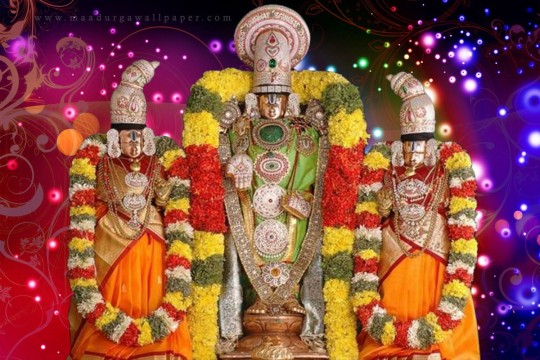
Benefits:
The prayer protects the individual from sliding into unsocial, sinful activity during the rest of the day. It reminds him of the need to be unselfish, and of his social responsibility thus awakening his conscience. He becomes a model and an example to others, too.
We are not, in fact waking him, but we waking the God in us. If we try to do it constantly we can realize him and attaint HIM. HE is the supreme Light, Our final Goal. Govinda is in our heart in the form of Soul a glowing lamp, so we say Utishto, Utishta Govinda.
Lord Sri Venkateshwara, the Supreme Savior of this sin filled Kali Yuga, shall certainly save all the devotees who unconditionally surrender themselves and all their problems to His holy Lotus feet.
How to recite: We, on raise from sleep, rub our hands, see both the Palms and recite the sloka:
Karagree Varthathey Lakshmi,Karamadhye Sarswathi, Karamoole stithe Gowri, Prabathe Kara Darshanam.
( Meaning Lakshmi resides in the Tip of the Hand, Saraswathi resides in the Middle, Gowri resides in Root. See the hand on Raise from sleep)
Daily Parayanam of Shri Venkateshvara Suprabhatam in the mornings in the brahmi muhurta was a ritual followed by many families even a couple of generations ago. If not so early, atleast even after the sunrise is good. If not daily, at least weekly parayana on every Saturday is known to be a highly beneficial activity for individuals and family as a whole.
Sri Venkateswara Suprabhatam Meaning:
O! Rama! Kausalya’s auspicious child! Twilight is approaching in the East. O! best of men! Wake up, the divine daily rituals have to be performed. ॥ 1 ॥
O! Govinda, wake up! O! Garudadhvaja! wake up. O! Kamalakanta! by rising, render the three worlds auspicious. ॥ 2 ॥
May it be an auspicious dawn to Thee, O! Goddess Lakshmi, the Mother of the Worlds, who dwells on the chest of Lord Vishnu, the enemy of the demons, Kaitabha and Madhu, of attractive and divine form, with the nature of granting what is desired by those seeking refuge! ॥ 3 ॥
May it be an auspicious dawn to Thee, O! Goddess Lakshmi, the beloved of the Lord of Vrsacala, with eyes like lotus petals, with a bright face like the Moon, who is worshiped by Girija, Vani, and Pulomaja and who is very compassionate. ॥ 4 ॥
Having worshiped the morning twilight and said their morning prayers, called sandhyavandana, the seven sages like Atri, bringing the beautiful lotuses from the divine Ganges, have arrived to worship Thy feet. Lord of Seshachala! May it be an auspicious dawn to Thee. ॥ 5 ॥
The Gods, like the five-headed Lord Brahma, Lord Subrahmanya, Lord Shiva, and Indra are praising the deeds of your incarnation as the Trivikramavatara. Nearby is Brhaspati who is reading out the planetary position of the day. Lord of Seshachala! May it be an auspicious dawn to Thee. ॥ 6 ॥
The breeze, carrying the wonderful fragrance of the partly opened lotuses, and the beautiful trees like the Coconut and Areca, is blowing gently. Lord of Seshachala! May it be an auspicious dawn to Thee. ॥ 7 ॥
The parrots in their cages are opening their eyes, and graciously singing, after eating the remains of the plantain fruits and the payasam in the vessels. Lord Seshachala! May it be an auspicious dawn to Thee. ॥ 8 ॥
The sage, Narada, is playing sweet music with his veena, and, in fine language, is singing praises of Thy endless deeds, gracefully waving his other hand. Lord of Seshachala! May it be an auspicious dawn to Thee. ॥ 9 ॥
The humming swarm of bees is sucking honey and emerging from the interiors of the lotuses of the adjoining pools, in order to serve Thee. Lord of Seshachala! May it be an auspicious dawn to Thee. ॥ 10 ॥
While the womenfolk of the hamlet of cowherds churn the curds, the loud sounds and echoes emanating from the pots seem like as if the pots and the eight directions are quarreling. Lord of Seshachala! May it be an auspicious dawn to Thee. ॥ 11 ॥
The swarm of bees in the lotuses are friends of the sun and are making loud sounds with a view to surpassing the splendor of the lustrous blue lotuses. Lord of Seshachala! May it be an auspicious dawn to Thee. ॥ 12 ॥
One with Lakshmi! One who grants boons! Friend of all the worlds! Abode of Sri Lakshmi! The matchless ocean of compassion! One having a charming form on account of the chest which is the abode of Sri Lakshmi! Lord of Venkatachala! May it be an auspicious dawn to Thee. ॥ 13 ॥
Lord Brahma, Lord Shiva, Lord Sanandana and several others have bathed in purified water. They are at your doorstep eager to see you, for their own well-being, though they have been hit with canes by your gods. Lord of Venkatachala! May it be an auspicious dawn to Thee. ॥ 14 ॥
Lord of Venkatachala! Thy abode is always called by several names, such as Sri Sesasaila, Narayanadri, Garudachala, Venkatadri, Vrsabhadri, Vrsadri. May it be an auspicious dawn to Thee. ॥ 15 ॥
Lord Siva, Indra, Agni, Yama, Nairuti, Varuna, Vayu and Kubera, with folded hands placed on their heads, are desirous of offering service to thee. Lord of Venkatachala! May it be an auspicious dawn to Thee. ॥ 16 ॥
The modes of Thy conveyance – Garuda, the Lord of Birds, the Lion, Lord of Animals, Adisesa, the Lord of Serpents, Airavata, the Lord of Elephants and Uccaissravas, the Lord of Horses – are begging Thee to grant them their respective authority and power to serve the Thee better, on your pleasure trips. Lord of Venkatachala! May it be an auspicious dawn to Thee. ॥ 17 ॥
The main deities of the Assembly of Gods – the nine planets – the Sun, the Moon, Mars, Mercury, Jupiter, Venus, Saturn, Rahu and Ketu are happy to serve even your servants and remain most obedient to Thee. Lord of Venkatachala! May it be an auspicious dawn to Thee. ॥ 18 ॥
Lord of Venkatachala! Thy devotees, whose heads are sanctified by the dust of Thy feet, being in Thy presence, do not desire Heaven or Liberation, but are worried that another Kalpa will start when there will be no such glory to Venkatachala! Lord of Venkatachala! May it be an auspicious dawn to Thee. ॥ 19 ॥
On seeing the crests of Thy temple tower, the mortals, who are attempting to attain the exalted paths of Heaven and Liberation, feel like living on in the mortal world, as it gives them the opportunity of worshipping Thee. Lord of Venkatachala! May it be an auspicious dawn to Thee. ॥ 20 ॥
Lord of Sridevi and Bhudevi! The ocean of nectar of compassion and other virtues! The chief of the Gods! The sole refuge of the Universe! The possessor of Sri! One whose feet are worshipped by Ananta and Garuda! Lord of Venkatachala! May it be an auspicious dawn to Thee. ॥ 21 ॥
Padmanabha! Purushottama! Vasudeva! Vaikunta! Madhava! Janardana! Chakrapani! Bearer of the mole Srivatsa! The celestial tree under whom refuge is sought! Lord of Venkatachala! May it be an auspicious dawn to Thee. ॥ 22 ॥
Bearer of the charming and divine form surpassing the pride of Cupid! One whose sight is fondly centred on the lotus bud like breasts of His beloved! The abode of auspicious and pure virtues! The possessor of Divine fame! Lord of Venkatachala! May it be an auspicious dawn to Thee. ॥ 23 ॥
Lord in ten incarnations of Matsya, Kamatha, Kola, Narasimha, Trivikrama, Parasurama, Rama, Balarama, Krishna and Kalki! Lord of Venkatachala! May it be an auspicious dawn to Thee. ॥ 24 ॥
The Brahmins, well-versed in the Vedas, are now joyfully waiting to worship you. They are carrying golden pots on their heads that are filled with the water of the Divine Ganges, which has been rendered fragrant by mixing cardamom, cloves and camphor in it. Lord of Venkatachala! May it be an auspicious dawn to Thee. ॥ 25 ॥
The Sun is rising; the lotuses have blossomed; the birds are twittering; the Sri Vaishnavas, always imploring auspiciousness, are waiting at Thy abode. Lord of Venkatachala! May it be an auspicious dawn to Thee. ॥ 26 ॥
Lord Brahma, the great sages and the good Yogins as Sanandana are waiting at Thy abode, with auspicious offerings in their hands. Lord of Venkatachala! May it be an auspicious dawn to Thee. ॥ 27 ॥
Abode of Lakshmi! Ocean of faultless and auspicious virtues! Bridge to cross the ocean of transmigration! One whose glory is known through the Upanishads! One who is enjoyed by devotees! Lord of Venkatachala! May it be an auspicious dawn to Thee. ॥ 28 ॥
Thus here is the Suprabhatam of the Lord of Vrishachala! Within the humans who are engaged in reciting it daily, the remembrance gives birth to the superior intellect, which makes the supreme goal easy to achieve. ॥ 29 II
#venkateswara#venkatesh#suprabhat#vishnu#lordvishnu#vishnupuran#krishna#hare krishna#harekrishna#lordkrishna#lord krishna
6 notes
·
View notes
Text
பூலோக வைகுண்டம் ஸ்ரீரங்கம் ஸ்ரீ ரங்கநாத சுவாமி திருக்கோயிலில் வைகுண்ட ஏகாதசி சொர்க்கவாசல் திறப்பு.
🙏🙏🙏🙏🙏 Vaikunda Ekaadashi. Opening the doors of Bhoolaka Vaikundam at Srirangam Sri Ranganatha Swami temple 2.1.23
5 notes
·
View notes
Photo
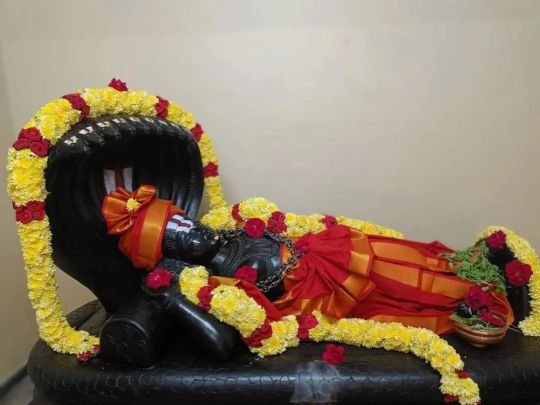
Sri Ranganatha Swamy Bhadrachalam (at Sita Ramachandraswamy temple, Bhadrachalam) https://www.instagram.com/p/CoUyL4gP5gj/?igshid=NGJjMDIxMWI=
2 notes
·
View notes
Text
5 Best Road Trips in India in 2024, Day 5/5- Chennai to Munnar
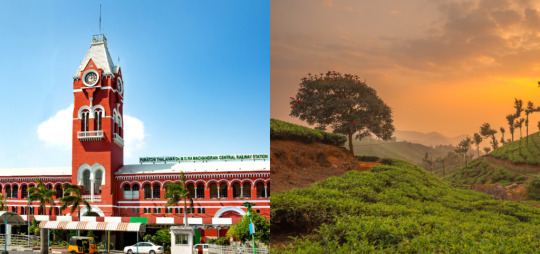
Lets Start a trip with Geniefie Nano Itineray Feature to explore and include all known and unexplored places in between Chennai to Munnar !!!
Welcome to our trip planner app, where we’re thrilled to guide you on an unforgettable road trip through the picturesque landscapes of Tamil Nadu and Kerala. Buckle up and get ready to explore the beauty of southern India as we journey from the vibrant city of Chennai to the serene hill station of Munnar.
Chennai to Munnar is a beautiful road trip for those who enjoy natural beauty. Along the way, you will find lots of greenery, beautiful waterfalls, pristine lakes and endless viewpoints. Munnar is a beautiful hill station and full of tea and spice plantations. And is you are a nature lover, this journey will top your list of best road trips in India.
Route 1: Chennai to Munnar via Bodi Ghat
Start–
Chennai → Our journey begins in the bustling metropolis of Chennai, where ancient temples, colonial architecture, and sandy beaches await exploration. Before hitting the road, take some time to soak in the vibrant culture of the city and indulge in some delicious South Indian cuisine.
Villupuram → As we leave Chennai behind, our first stop is Villupuram, a charming town known for its lush greenery and tranquil ambiance. Stretch your legs, grab a snack, and take a moment to appreciate the scenic beauty of the countryside before continuing our journey towards Trichy.
Tiruchirapalli (Trichy) → Our next destination is the historic city of Tiruchirapalli, also known as Trichy, which boasts a rich cultural heritage and iconic landmarks such as the Rock Fort Temple and Sri Ranganathaswamy Temple. Explore the ancient architecture, immerse yourself in the local culture, and don’t forget to capture the breathtaking views from atop the rock fort before moving on.
Theni → Continuing our expedition, we arrive in Theni, a picturesque town nestled in the Western Ghats known for its lush greenery, tea plantations, and cascading waterfalls. Take a break from the road and explore the natural beauty of the region, including the serene Vaigai Dam and the majestic Meghamalai hills.
Bodi Ghat → Our journey takes us through the scenic Bodi Ghat, a winding mountain pass that offers panoramic views of the surrounding valleys and forests. Drive carefully as you navigate the hairpin bends and steep inclines, and don’t forget to stop and admire the stunning vistas along the way.
Munnar → Our final destination awaits as we arrive in the enchanting hill station of Munnar, nestled amidst the rolling hills of the Western Ghats. Explore the lush tea plantations, trek through the scenic trails, and breathe in the crisp mountain air as you immerse yourself in the natural beauty of this serene destination.
End
Distance: 583 km
Popular Stopovers: Tiruchirapalli Rock Fort, Sri Ranganatha Swamy Temple and multiple waterfall pit stops.
Route 2: Chennai to Munnar via Udumalpet
Start–
Chennai → Our adventure begins in the vibrant city of Chennai, where ancient temples, bustling markets, and pristine beaches await exploration. Before hitting the road, take some time to soak in the rich culture and heritage of the city, and indulge in some mouthwatering South Indian delicacies.
Villupuram → As we leave Chennai behind, our first stop is Villupuram, a charming town surrounded by lush greenery and tranquil lakes. Stretch your legs, grab a snack, and enjoy the peaceful ambiance of the countryside before continuing our journey towards Tiruchirappalli.
Tiruchirappalli → Our next destination is the historic city of Tiruchirappalli, also known as Trichy, which is home to ancient temples, majestic forts, and bustling markets. Explore iconic landmarks such as the Rock Fort Temple and Srirangam Temple, and immerse yourself in the rich cultural heritage of the region before moving on.
Dindigul → Continuing our expedition, we arrive in Dindigul, a picturesque town nestled amidst the rolling hills of Tamil Nadu. Explore the historic Dindigul Fort, sample local delicacies like Dindigul biryani, and take in the scenic beauty of the surrounding countryside before heading towards Udumalpet.
Udumalpet → Our journey takes us through the charming town of Udumalpet, known for its lush greenery, serene lakes, and vibrant markets. Take a break from the road and explore the natural beauty of the region, including the picturesque Thirumurthy Dam and the tranquil Amaravathi Reservoir.
Munnar → Our final destination awaits as we arrive in the breathtaking hill station of Munnar, nestled amidst the majestic Western Ghats. Explore the lush tea plantations, trek through scenic trails, and soak in the panoramic views of the surrounding mountains and valleys as you immerse yourself in the natural beauty of this enchanting destination.
End
Distance: 596 km
Popular Stopovers: Thirumoorthy Hills, Sirumalai Reserved forest and multiple waterfall pit stops.
On the road trip from Chennai to Munnar, you can also take a detour to Pondicherry and enjoy some relaxing time on the beach.
Apart from being a thrilling and adventurous experience, road trips require less planning and are perfect even for a short or a weekend getaway. Tell us in the comments below, how many of these best road trips from Geniefie Nano and Hidden Gems in India have you done!
We are going to give you tons of travel goals and have lots of fun together!! Till then, stay tuned, keep saving, keep exploring, and Happy Travel!!
Trip Planner App
0 notes
Text
Temple Research Pt6
Sri Ranganatha Swamy:
Sri Ranganatha Swamy Temple, located in Srirangam, Tamil Nadu, India, is one of the largest temple complexes in the world. Dedicated to Lord Ranganatha, a form of the Hindu god Vishnu, the temple is renowned for its architectural grandeur and spiritual significance. It spans over a sprawling area and is surrounded by seven concentric walled enclosures, reflecting its historical and cultural importance. The main shrine houses a reclining statue of Lord Ranganatha, measuring about 6 meters (20 feet) in length, representing the deity in a resting posture on the serpent god Adisesha. The temple attracts thousands of devotees and tourists alike, drawn not only by its religious sanctity but also by its exquisite craftsmanship and intricate carvings, making it a must-visit destination for anyone interested in India's rich cultural heritage.

This temple is very fascinating, it has such vibrant colouring and such a weird shape for a building that I haven't seen before. I think it looks really spectacular but it doesn't fit what I am looking for. I think the colours are to vibrant and out there and I think the shape just doesn't fit the whole ancient Egypt type of civilisation. If I was looking for an ancient civilisation with old Asian architecture then I would look at this. But due to the reasons I have already stated I will not be using this for inspiration.
1 note
·
View note
Text
Sri Ranganatha Swamy (Rarest Darshan) (Vishnu) - Don't Miss it!
#ranganathaswami#sriranganathaswami#srirangam#lord narayana#lord vishnu sleeping#hinduism#krishna#hindu mythology#hare krishna#iskcon#sanatandharma#rama#hindusim#ramayana#hindu
0 notes
Text
09 Nights 10 Days South India Tour Packages From Chennai To Trivandrum
+91-74181-33135 / [email protected]
09 Nights 10 Days South India Tour Packages From Chennai To Trivandrum
Pickup: Chennai
Drop: Trivandrum
DAY 1 : Spiritual Sojourn from Chennai to Mahabalipuram via Kanchipuram
Depart from Chennai and head towards Kanchipuram. Explore the Kanchi Kamatchi Amman Temple before continuing on to Mahaballipuram. Check into your hotel for the night and enjoy your stay.
DAY 2 : Coastal Charms and Spiritual Tranquility
In the morning, after checking out, you can explore various attractions such as the Shore Temple, Krishna's Butter Ball, the Descent of the Ganga River, the India Seashell Museum, the Arulmigu Sri Sthala Sayana Perumal Temple, the Tiger Cave, Mahabalipuram Beach, the Varaha Cave, and the Group of Monuments. Afterward, you can drive to Thiruvannamalai to visit the Arunachalam temple before transferring to Pondicherry for an overnight stay.
DAY 3 : Spiritual and Cultural Expedition from Pondicherry to Kumbakonam via Chidambaram
Begin your day with a visit to the Arulmigu Manakula Vinayagar Devasthanam, Sri Aurobindo Ashram, The Sacred Heart Basilica, Immaculate Conception Cathedral, and Rock Beach in Pondicherry. Enjoy the stunning sunrise views along a rocky breakwater before heading to the Sri Varadaraja Perumal Temple, Puducherry Museum, Bharathi Park, and French War Memorial. Afterward, transfer to Chitambaram to visit the world-famous Natarajar Temple before driving to Swamimalai for lunch. Finally, check-in at your hotel in Kumbakonam for a night's stay.
DAY 4 : Temples and Tradition - Kumbakonam to Tanjore
In the morning of this day, after checking out, make a visit to Navagraha Temple. Following that, drive to Tanjore and check in at the hotel. Later, visit the magnificent Tanjore Big Temple and spend the night there.
DAY 5 : Temples Galore - Tanjore to Trichy to Madurai
After checking out, explore the Brahmapureeswarar Temple, Sree Ranganatha Swamy Temple, and Thiruvanaikaval Siva Temple before heading to Madurai to check in at your hotel. Take time to visit the Meenakshi Amman Temple, Thirupanakundram, Alager Coil, Palamudhircholai, Thirumalai Naikker Mahal, and Theppakulam Lake before retiring for the night at your hotel.
DAY 6 : Sacred Pilgrimage - Madurai to Rameswaram
On the day after checking out, proceed to Rameswaram and make a stop at the world's first Parvati Temple in Utragosamangai, Thirupulani Vishu Temple, and the Pamban Bridge. Check-in at the hotel, and in the evening, visit Agni Theertham, 22 Kund, and Ramanatha Swamy Temple. Spend the night at the hotel.
DAY 7 : From Sacred to Serenity - Rameswaram to Kodaikanal
Begin your day by visiting the Jyotirlinga Spadina Linga Pooja in the early morning. After checking out, explore the Ramer FootPrint, Kalam House, Jada Kund, Koothanda Ramar Temple, Dhanushkodi, Ram Setu, Villundi Kund, Seetha Kund, Lakshamna Kund, and the Five Face Hanuman Mandir. Then, proceed towards Kodaikanal and make a stop at the Manjal Aaru Dam and Silver Falls en route. Once you reach Kodaikanal, check into your hotel (arranged by the customer). In the evening, take a leisurely stroll along Cookers Walk, visit Kodai Lake, enjoy boating, and explore Bryant Park. Finally, return to your hotel for a comfortable night's stay.
DAY 8 : Tranquil Charms of Kodaikanal
Explore the wonders of nature by visiting Pillar Rock, Fine Forest, Solar Observatory, Kurunji Andavar Temple, and Lakshmi Temple. Take in the breathtaking views at Palani View Point and learn about the local flora and fauna at Shembaganur Museum and Rabit Form. End your day with a serene boat ride at Mannavanur Lake before returning to your hotel for a peaceful night's rest.
DAY 9 : From Hills to Confluence - Kodaikanal to Kanyakumari
Begin the day by checking out of the hotel and driving to Kanyakumari. Upon arrival, check in at the hotel. In the evening, explore the Triveni Sangam, Sun Set Point, and Kanyakumari Amman Temple. Return to the hotel for the night.
DAY 10 : A Day of Cultural Riches - Kanyakumari to Thiruvananthapuram
On the tenth day, start your morning by witnessing the beautiful sunrise at SunRise Point. After checking out, make a visit to the Vivekananda Memorial, Thiruvalluvar Statue, Gandhi Museum, and Kamarajar Museum. Don't miss the opportunity to climb the WatchTower and explore the Sri Venkateswara Swamy Temple, Suchindram Temple, and Padmanabhapuram Palace. Take a leisurely stroll across the Mathoor Walking Bridge and pay your respects at the Sree Padmanabhaswamy Temple. Finally, relax at the scenic Shangumugham Beach before heading to Thiruvananthapuram Airport or Railway Station for your departure.
#southindiatourpackageswithitineary#templetour#tour package#southindiatourstravelsmadurai#10daystamilnadutourpackage
0 notes
Text
Spent time at the magnificent Sri Ranganatha Swamy Temple in Tiruchirappalli and prayed for the well-being and prosperity of fellow countrymen.
- PM Modi
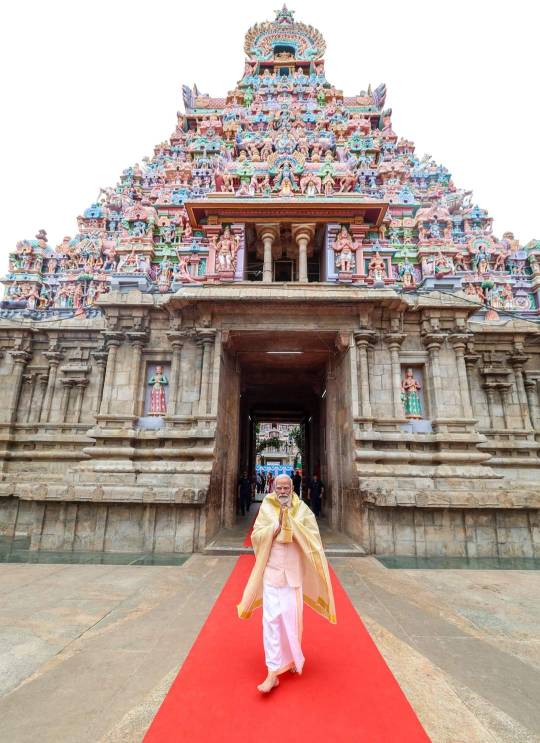
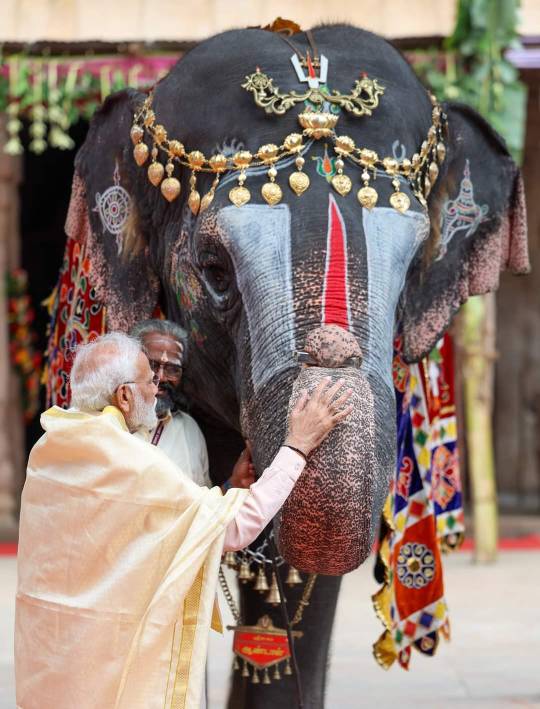

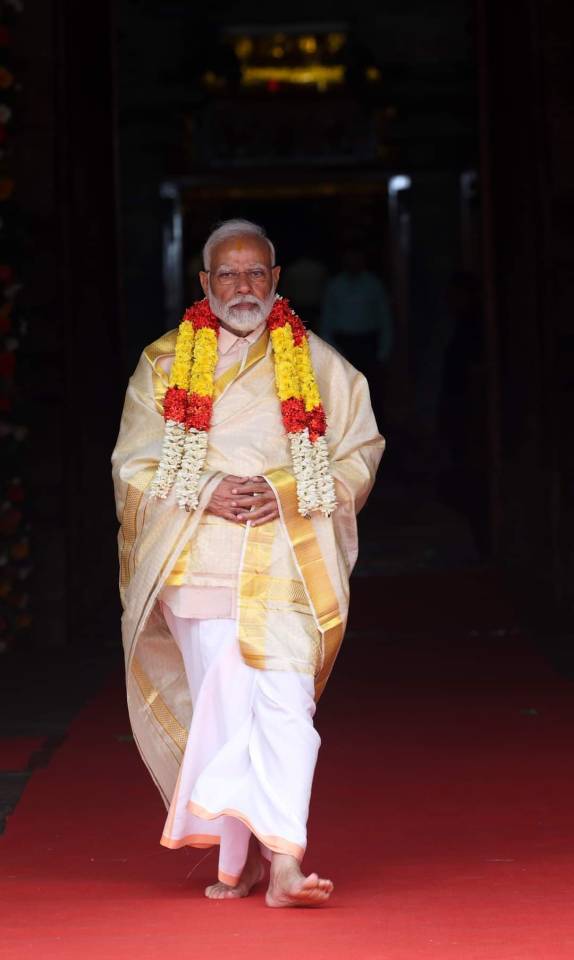
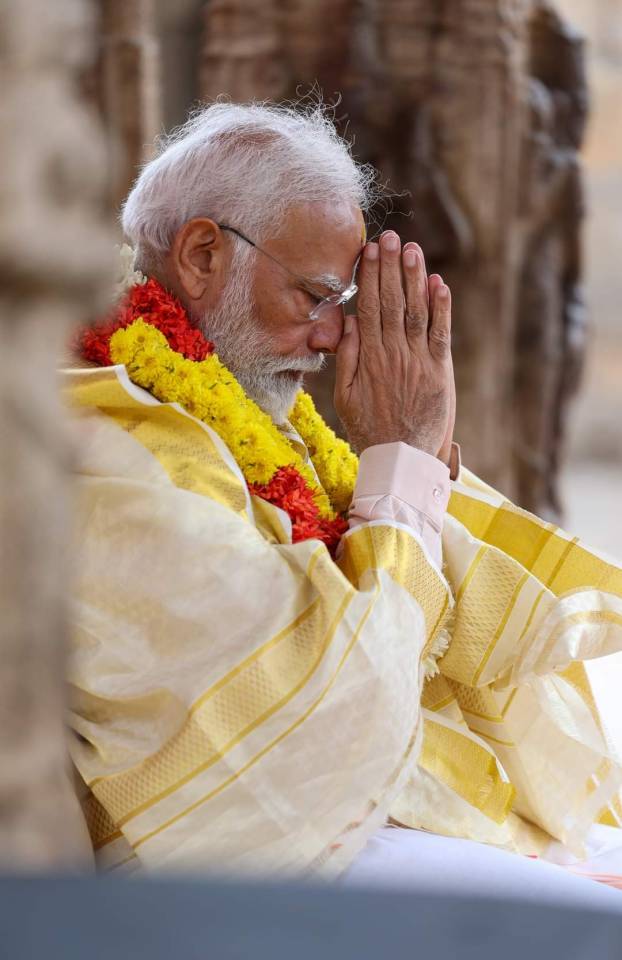



0 notes
Text

Sri Ranganatha Swamy Temple - INDIA
95 notes
·
View notes
Text
Women entering temples as priests in TN under Dravidian model, says Tamil Nadu CM
They will be undergoing one-year training in different temples soon.
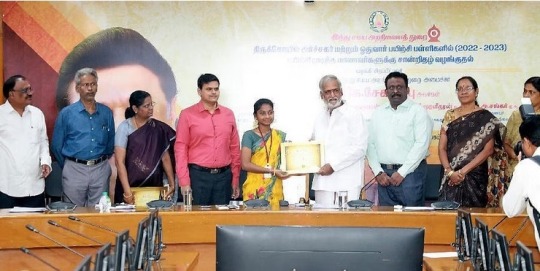
CHENNAI: Three women graduates, who are in their mid-20s and successfully completed their archaka course in the training centre run by the Sri Ranganatha Swamy Temple in Srirangam are ready to take up the job of archakas. They will be undergoing one-year training in different temples soon. Interestingly, the Archaka Training Centre in Srirangam has drawn 11 more women students this year, and other centres in the state may draw more women students in due course.
N Ranjitha (25) of Vellamathagu Koradacheri in Tiruvarur district, S Ramya (23), and C Krishnaveni (23) of Mel Adhanur village in Cuddalore district received the course completion certificate from HR &CE Minister PK Sekarbabu on Wednesday.
While Ranjitha is a B.Sc (visual communication) graduate, Ramya is a M.Sc (maths) graduate. Krishnaveni holds a graduate degree in mathematics. Though there are women priests in certain village temples and other places already, women who have completed a proper course on priesthood entering the sanctum sanctorum of HR and CE temples is a significant development.
N Ranjitha (25) told TNIE that during the one-year course, they were taught Pancharatra Agama, Naalaayira Divya Prabhandam, Nitya Anusandanam, how to perform ‘homams’ and other information on worship in temples. “The training we will be undergoing in the coming months will make us completely able to perform rituals on our own,” she exuded confidence.
Ranjitha said she is expected to get her training in Mannargudi Rajagopalaswamy Temple after September 20 while Krishnaveni requested the department that she be given training in Perambalur Manada Gopalaswamy Temple. Ramya wishes to get trained in a nearby temple. They were told that after one year of training if there were vacancies in those temples, they would be appointed as assistant priests. Otherwise, they would get appointments in other temples.
One of them belongs to the Pallar community while two belong to the Valluvar community. They are not worried about the income and just want to earn ‘punyam’ by serving the Lord. Hailing the three women who will be entering the sanctum sanctorum of temples, Chief Minister MK Stalin, in a message on X (formerly Twitter), said, “As our Dravidian Model government has removed the thorn from Thanthai Periyar’s heart by appointing people of all castes as priests, women are also stepping into sanctums, bringing a new era of inclusivity and equality.”
Stalin also said that despite women’s achievements as pilots and astronauts, they were barred from the sacred role of temple priests, deemed impure, even in temples for female deities. “But change is finally here!” he added. DMK deputy general secretary Kanimozhi congratulated the three women.
“The voice of these three women from where they were denied entry, will turn a new chapter in the social justice history of the state. I thank the chief minister and HR&CE Minister who made this possible.”
38 archakas & 8 women Othuvars appointed
DHARMAPURI: The DMK government has appointed 38 people as archakas from all castes and eight women as ‘Othuvars’, HRCE Minister PK Sekarbabu said on Thursday. Addressing reporters after conducting inspections in temples in Salem and Dharmapuri, he said, “
Recently 94 priests completed their training from 20 priest training schools. Among them are three women archakas and four othurvars. In Tamil Nadu, people can become temple priests irrespective of their caste. So far, 38 non-Brahmins have been appointed in temples as priests.”
“Since the DMK came to power, over 1,044 temples have been consecrated. 90% of the renovation works of the 850-year-old Salem Kottai Mariamman Thirukovil, which began in 2016 at the cost of `4.35 crore, is completed,” he added.
The minister further stated that the state government has so far surveyed over 1.50 lakh acres of HR&CE land belonging to various temples and marked their boundaries with stones. In the last two years, properties worth Rs 5,213 crore belonging to HR&CE have been recovered, he added.
0 notes
Text
#9Nights10DaysTamilnaduKeralaTourPackage
#KeralaPackagesfor9Nights10Days
#RomanticEscapeKeralaPackage10Days9Nights
#MagicalKeralaVacationPackage10Days9Nights
#9Nights10DaysKeralaTourPackagesItineraryTrip
Contact :
https://www.madurairameshwaramkanyakumaritrivandrumtourpackage.com/
+91 452 406 8791
+91 7418133135
#Chennai #Mahabalipuram #Pondicherry #Chitambaram #Kumbakonam #Tanjore #Trichy #Madurai #Rameswaram #Kanyakumari #Trivandrum
Trip Details Itinerary
Day 01 Pickup from Chennai Checkin Hotel Visit Isckon Temple, Matsya Narayana Swamy Temple, Mutrukadu Boat House, Kovalam Beach, Nithya Kalyana Perumal Temple, Madras Crocodile Park, Evening Visit Merina Beach Return Back to Hotel Night Stay
Day 02 This Day Morning After Checkout Proceed to Mahaballipuram Visit Shore Temple, Krishna's Butter Ball, Descent of the Ganga River, India Seashell Museum, Arulmigu Sri Sthala Sayana Perumal Temple, Tiger Cave, Mahabalipuram Beach, Varaha Cave, Group of Monuments at Mahabalipuram Night Stay in Pondicherry
Day 03 This Day Morning Visit Pondicherry Visit Arulmigu Manakula Vinayagar Devasthanam, Sri Aurobindo Ashram, The Sacred Heart Basilica, Immaculate Conception Cathedral, Rock Beach, Sunrise views along a rocky breakwater, Sri Varadaraja Perumal Temple, Puducherry Museum, Bharathi Park, French War Memorial Return Back to Hotel Night Stay
Day 04 This Day Morning After Checkout Transfer to Chitambaram Visit World Famous Natarajar Temple and Drive to Swamimalai after Lunch Proceed Kumbakonam Checkin Hotel Night Stay
Day 05 This Day Morning After Checkout Visit Navagraha Temples then Evening Visit Tanjore Big Temple Transfer to Trichy Checkin Hotel Night Stay
Day 06 This Day After Checkout Visit Brahmapureeswarar Temple, Sree Ranganatha Swamy Temple, Thiruvanaikaval Siva Temple proceed to Madurai Checkin Hotel Visit Meenakshi Amman Temple, Thirupanakundram, Alager Coil, Palamudhircholai, Thirumalai Naikker Mahal, Theppakulam Lake Stay in Hotel
Day 07 After Check Out Move to Rameswaram OnRoute Visit world's first parvati Temple in Utragosamangai, Thirupulani Vishu Temple, Pamban Bridge Check-in HOTEL Evening Visit Agni Theertham, 22 Kund, Ramanatha Swamy Temple, Night Stay
Day 08 This Day Visit Early Morning Jothir Linga Spadina Linga Booja, After Check Out Visit Ramer Foot Print, Kalam House, Jada Kund, Koothanda Ramer Temple, Dhanushkodi, ram Setu, Villundi Kund, Seetha Kund, Lakshamna Kund, Five Face Hanuman mandir, Move Kanyakumari Check-in HOTEL Evening Visit Triveni sangam, Sun Set Point, Kanyakumari Amman Temple Back to Hotel Night Stay
Day 09 Early Morning SunRise Point, After Check Out Visit Vivegantha Memorial, Thiruvalluvar Statue, Gandhi Museum, Kamarajar Museum, Watch Tower, Sri Venkadeswara Swamy Temple, Suceendram Temple, Padmanatha puram Palace, Mathoor Walking Bridge, Proceed to Kovalam Check in HOTEL Evening Visit Beach and Water Sports Return Back to Hotel Night Stay
Day 10 This Day After Checkout Visit Sree Padmanatha Swamy, Temple, Shangumugam Beach, Attukkal Bagavathi Amman Temple, Arcod Museum, Thiruvanthapuram Zoo Back to Airport / Railway Station Drop
0 notes
Text
Sri Ranganatha swamy Temple Mysore:History,Temple Timings

Mysore, the well-known city of heritage, is also a place of devotion and elegant temples. This is the perfect destination for family outings and friends’ get-togethers. If you are thinking about
spending quality time in the city to experience exciting things, you should visit the Sri Ranganathaswamy temple near Mysore, Karnataka.
This worship place is one of Mysore, Karnataka’s most revered and prominent shrines. It is located in Srirangapatna, in the Mandya district near the city of Mysore, in Karnataka, India. This temple is famous for
its stunning architecture and history. Many people visit this temple as it holds a lot of religious and spiritual significance because it is dedicated to lord Ranganatha, a form of the significant Hindu deity Maha Vishnu.
A brief history of Sri Ranganathaswamy Temple
The devotees believe this temple is the first and the most important of the 108 main Divya Desams. This temple has a long history. The architecture of this temple is an example of the artistic brilliance of the artists of the ancient era. An inscription suggests that this temple was built in 984 A.D. by Ganga Chieftain, Thirumalaiah. However, other significant figures such as Hoysala, Vijayanagara, Haider Ali, and Mysore Wodeyars also contribute to this temple.
According to mythology, once in the Himalayas, the personified rivers Kaveri, Ganga, Yamuna, and Saraswati were playing. One Gandharva saw these sacred rivers playing and worshiped them from the sky. However, all the river started arguing about whom did he worship? After some time, Yamuna and Saraswati rivers stopped complaining, but the Kaveri and Ganga didn’t. Finally, they both approached Maha Vishnu for the answer. The River Kaveri pleased Lord Vishnu by forming three huge islands,
Srirangapatna, Shivanasamudra, and Srirangam. The temple is built on her bank to please Lord Vishnu
The Architecture of Sri Ranganathaswamy Temple
This temple was built in the Vijayanagar and Hoysala style and dedicated to the Supreme God, Lord Vishnu. This temple has four glorious pillars beautifully carved with 24 forms of Lord Vishnu. This temple
also includes shrines of other deities such as Narsimha, Rama, Ranganayaki, Gopalakrishna, Sudarshana,
Srinivasa, and Panchamukha Anjaneya.
Many scholars believe that the rulers of the Hoysala dynasty were big fans and supporters of the art of carving and its artisans. You can see that support in the temple work. It has glorious paintings depicting
mythological events. This temple held great significance in archaeological and epigraphical sites as it offered a historical window into the early and mid-medieval south Indian culture and society.
Temple Timings
Generally, you can visit this temple between the time from 6:00 am to 9:00 pm all days of the week. If you are seeing this temple for Pooja and darshan, you should know the timing of each Pooja. The Viswaroopa Seva starts at 6:00 am and ends at 7:15 am. You can perform Pooja after this ceremony from 7:15 am to 9:00 am. Next, darshan starts from 9:00 am to 12:00 pm, and after it, you can do Pooja from 2:00 pm to 1:15 pm. The darshan timing after lunch starts at 1:15 pm and ends at 6:00 pm. You can visit this temple from 6:00 pm to 6:45 pm for the evening pooja. The last darshan ends at 9:00 pm until the temple closes
What are the clothing rules for visiting the Sri Ranganathaswamy temple?
Most people visit this temple to perform poojas and visit to see the architecture as well as the scenic beauty. If you are here to sponsor Pooja, you should follow the proper traditional attire. All men are requested to wear dhotis & Angavastras, and all women should wear a saree as an appropriate dress code to enter this temple. However, Indian wear is not entirely required. You can wear other clothes such as full-length trousers, shirts, shirts with tops, and other clothing that covers your body appropriately.
Things to do in Mysore
There are more things to do in Mysore, along with visiting the Sri Ranganathaswamy temple. In addition, you can see other famous temples in Mysore (Karnataka), such as the Madhya Ranga Temple (in Shivanasamudra).
You can also visit other attractions of this place when travelling to Mysore, including Sri Chamarajendra Zoological Gardens, Brindavan Gardens, Mysore Palaces, Karanji Lake, and more. However, here is a list
of hidden gems, you can witness in Mysore.
1.Admire art
You can admire the splendid artwork at Jaganmohan palace, along with Mysore Palace. The magnificence of Jaganmohan palace shows in its Hindu-style architecture. You can find here paintings of various artists across the globe.
2.Ride Tonga
Nothing can beat the ride of tonga, as it is one of the most favourable tourist attractions. However, Mysore is one of those lost cities of India where you can still ride on a tonga. It is a horse-drawn carriage
that brings back the soul to the old days when tongas were a common means of transportation.
3.Witness the Beauty of the Waterfall
Shivanasamudra waterfalls are the perfect place for a day out. You can explore the waterfall’s beauty and get a peaceful and calm atmosphere. This is the ideal place for a nature lover.
4.Stroll around in a Beautiful garden
Brindavan Garden is the best place to stroll around as you can witness the sweet smell of flowers, pleasant breeze, sprawling lush green atmosphere, and a sense of calm. These things make this place
perfect for a calm walk with your friends and family.
5.Night Walk
You should quickly start online booking your Mysore night walk to witness the pleasant and unforgettable experience. These night walks begin at seven in the evening and will take you to various leading temples, landmarks, and markets of Mysore to let you get the essence of the city.
Mysore is one of the oldest and holiest cities in India. You can find many splendid temples and architecture like Sri Ranganathaswamy temple. It is worth visiting Mysore as it gives you a marvelous experience of nature, architecture, devotion, and cultural heritage altogether.
Article Source: Sri Ranganatha swamy Temple Mysore:History,Temple Timings
For more articles like this, Please visit Puja N Pujari
1 note
·
View note
Video
youtube
Sri Ranganatha Swamy Temple Tiruchirapalli| Srirangam| Dr. Jayarama Redd...
0 notes